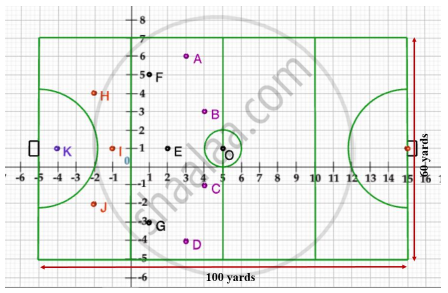Advertisements
Advertisements
Question
Find the values of y for which the distance between the points P (2, -3) and Q (10, y) is 10 units.
Solution 1
PQ = `sqrt((x_2 - x_1)^2 + (y_2 - y_1)^2)`
⇒ `sqrt((10 - 2)^2 + (y + 3)^2) = 10`
⇒ (8)2 + (y + 3)2 = 100
⇒ 64 + y2 + 6y + 9 = 100
⇒ y2 + 6y + 73 - 100 = 0
⇒ y2 + 6y - 27 = 0
⇒ y2 + 9y - 3y - 27 = 0
⇒ y(y + 9) - 3(y + 9) = 0
⇒ (y + 9) (y - 3) = 0
⇒ y + 9 = 0
⇒ y = -9
and y - 3 = 0
⇒ y = 3
Solution 2
The distance d between two points `(x_1, y_1)` and `(x_2, y_2)` is given by the formula
d = `sqrt((x_1-x_2)^2 + (y_1 - y_2)^2)`
The distance between two points P(2,−3) and Q(10,y) is given as 10 units. Substituting these values in the formula for distance between two points, we have,
10 = `sqrt((2 - 10)^2 + (-3 - y)^2)`
Now, squaring the above equation on both sides of the equals sign
100 = (-8)2 + (-3 - y)2
100 = 64 + 9 + y2 + 6y
27 = y2 + 6y
Thus, we arrive at a quadratic equation. Let us solve this now.
y2 + 6y - 27 = 0
y2 + 9y - 3y - 27 = 0
y(y + 9) - 3(y + 9) = 0
(y - 3) (y + 9) = 0
The roots of the above quadratic equation are thus 3 and −9.
Thus, the value of ‘y’ could either be 3 or -9.
APPEARS IN
RELATED QUESTIONS
If the point P(x, y) is equidistant from the points A(a + b, b – a) and B(a – b, a + b). Prove that bx = ay.
Find the distance between the following pair of points:
(asinα, −bcosα) and (−acos α, bsin α)
Show that the points A (1, −2), B (3, 6), C (5, 10) and D (3, 2) are the vertices of a parallelogram.
Find the circumcenter of the triangle whose vertices are (-2, -3), (-1, 0), (7, -6).
Find all possible values of x for which the distance between the points
A(x,-1) and B(5,3) is 5 units.
Show that the points A(1, 2), B(1, 6), C(1 + 2`sqrt3`, 4) are vertices of an equilateral triangle.
Find the distance of the following point from the origin :
(5 , 12)
Find the distance of the following point from the origin :
(0 , 11)
Find the value of a if the distance between the points (5 , a) and (1 , 5) is 5 units .
In what ratio does the point P(−4, y) divides the line segment joining the points A(−6, 10) and B(3, −8)? Hence find the value of y.
A point P lies on the x-axis and another point Q lies on the y-axis.
Write the abscissa of point Q.
Calculate the distance between A (7, 3) and B on the x-axis whose abscissa is 11.
Show that the quadrilateral with vertices (3, 2), (0, 5), (- 3, 2) and (0, -1) is a square.
Show that A(1, 2), (1, 6), C(1 + 2 `sqrt(3)`, 4) are vertices of a equilateral triangle
If the distance between the points (x, -1) and (3, 2) is 5, then the value of x is ______.
Case Study -2
A hockey field is the playing surface for the game of hockey. Historically, the game was played on natural turf (grass) but nowadays it is predominantly played on an artificial turf.
It is rectangular in shape - 100 yards by 60 yards. Goals consist of two upright posts placed equidistant from the centre of the backline, joined at the top by a horizontal crossbar. The inner edges of the posts must be 3.66 metres (4 yards) apart, and the lower edge of the crossbar must be 2.14 metres (7 feet) above the ground.
Each team plays with 11 players on the field during the game including the goalie. Positions you might play include -
- Forward: As shown by players A, B, C and D.
- Midfielders: As shown by players E, F and G.
- Fullbacks: As shown by players H, I and J.
- Goalie: As shown by player K.
Using the picture of a hockey field below, answer the questions that follow:

The point on x axis equidistant from I and E is ______.
The distance between the points A(0, 6) and B(0, –2) is ______.
Point P(0, 2) is the point of intersection of y-axis and perpendicular bisector of line segment joining the points A(–1, 1) and B(3, 3).
Show that points A(–1, –1), B(0, 1), C(1, 3) are collinear.
The distance of the point (5, 0) from the origin is ______.
